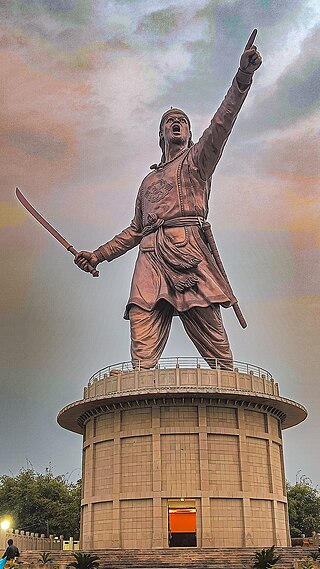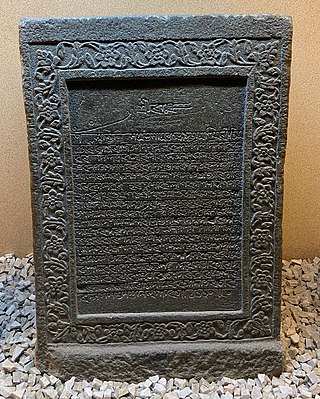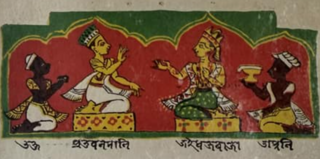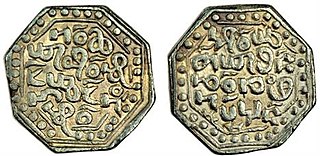
Lachit Borphukan was an Ahom Borphukan, primarily known for commanding the Ahom Army and the victory in the Battle of Saraighat (1671) that thwarted an invasion by the vastly superior Mughal Forces under the command of Ramsingh I. He died about a year later in April 1672.

The Battle of Saraighat was a naval battle fought in 1671 between the Mughal Empire, and the Ahom Kingdom on the Brahmaputra river at Saraighat, now in Guwahati, Assam, India. This was the decisive battle that ended the years long Mughal seige of Guwahati, with the Ahoms pushing away the Mughals west beyond the Manas river.

Koch Hajo (1581–1616) was the kingdom under Raghudev and his son Parikshit Narayan of the Koch dynasty that stretched from Sankosh River in the west to the Bhareli River in the east on the north bank of the Brahmaputra River. It was created by dividing the Kamata kingdom then under Nara Narayan in medieval Assam. The Sankosh River divided the two new kingdoms, and it is roughly the boundary between the present-day Assam and West Bengal. The western half of the Kamata kingdom emerged as Koch Bihar whereas the eastern half emerged as Koch Hajo. The name Hajo comes from the legendary king Hajo, a Koch tribal chief and an ancestor of the Koch dynasty, who ruled over the Rangpur division in present-day Bangladesh and some regions of present-day Assam.
There were three Burmese invasions of Assam between 1817 and 1826, during which time the Kingdom of Assam came under the control of Burma from 1821 to 1825. Locally, this period, called the manor din by the people of Assam, is remembered with horror. The sharp drop in population due both to depredations as well emigrations left the erstwhile kingdom in shambles. It was the climactic period of the Ahom kingdom. The British, who were earlier reluctant to colonise Assam, came into direct contact with a belligerent Burmese occupying force. Following the First Anglo-Burmese War they annexed Assam and took Manipur as a subsidiary state.

The Ahom kingdom was a late medieval kingdom in the Brahmaputra Valley that retained its independence for nearly 600 years despite encountering Mughal expansion in Northeast India. Established by Sukaphaa, a Tai prince from Mong Mao, it began as a mong in the upper reaches of the Brahmaputra based on wet rice agriculture. It expanded suddenly under Suhungmung in the 16th century and became multi-ethnic in character, casting a profound effect on the political and social life of the entire Brahmaputra valley. The kingdom became weaker with the rise of the Moamoria rebellion, and subsequently fell to repeated Burmese invasions of Assam. With the defeat of the Burmese after the First Anglo-Burmese War and the Treaty of Yandabo in 1826, control of the kingdom passed into East India Company hands.

Ahom–Mughal conflicts refers to the series of 17th-century conflicts between the Ahoms and the Mughals over the control of the Brahmaputra valley. It began soon after the eastern branch of the Kamata kingdom then under the Koch dynasty, Koch Hajo, collapsed after a sustained Mughal campaign bringing it face-to-face with the eastern Ahoms. After nearly seventy years of sustained efforts, the Mughals were finally ousted in the Battle of Itakhuli in 1682. The Mughals since then maintained interest to the region west of the Manas river via zamindars, till they were ousted from Bengal by the British about a hundred years later.

Sukhrungphaa or Swargadeo Rudra Singha was the 30th Ahom king, reigning from 1696 to 1714 A.D. His father Gadadhar Singha freed Assam from the Mughal disturbances and internal conspiracies, thereby Rudra Singha inherited a stable state and government and had the advantage of the solid foundations laid by his father. He devoted his time to transform Assam into a first-rate power in India. He stopped the persecution of the Neo-Vaisnava sect and built temples, several public works, and patronized art, literature, and culture. Rudra Singha is also famed for being the real father of Ahom architecture. He giving up the isolationist policy of his predecessors forged diplomatic ties with various states of that time and established extensive trade with Bengal.
Borboruah was one of the five patra mantris (councillors) in the Ahom kingdom, a position created by the Ahom king Prataap Singha in 1621. The position included both executive and judicial powers, with jurisdiction of the Ahom kingdom east of Kaliabor river and those regions not governed by the three great Gohains, and the princely estates. The region to the west of Kaliabor was governed by the Borphukan.

Borphukan was one of the five patra mantris (councillors) in the Ahom kingdom, a position that was created by the Ahom king Prataap Singha. The position included both executive and judicial powers, with jurisdiction of the Ahom kingdom west of Kaliabor river. The headquarters of Borphukan was based in Kaliabor and after the Battle of Itakhuli in 1681 in Itakhuli in Guwahati. This position was particularly important and powerful because of its distance from the Ahom capital, giving it a semblance of independence. The region to the east of Kaliabor was governed by the Borbarua. Lachit Deka later became Borphukan or the ruler of Lower Assam according to the fifth chronicles of the Satsori Asom Buranji.

Supangmung, also known as Chakradhwaj Singha, was an important Ahom king under whom the Ahom kingdom took back Guwahati from the Mughals following the reverses at the hands of Mir Jumla and the Treaty of Ghilajharighat. He is known for his fierce pride as an Ahom monarch.

Mir Jumla II, or Amir Jumla, also known as Ardistānī Mir Muhammad, was a military general, wealthy diamond trader, a Vizier of Golconda sultanate, and later a prominent subahdar of Bengal under the Mughal Emperor Aurangzeb.

Mir Jumla II invaded the Ahom kingdom in January 1662 and left it in January–February 1663. He was able to occupy Garhgaon, the Ahom capital, before the beginning of the rainy season, but he and his army were confined mostly to Garhgaon and Madhupur during that period. The Ahom king Sutamla had to take flight and hide in Namrup during Mir Jumla's occupation of the capital. The defection of Baduli Phukan, a high ranking Ahom commander, precipitated the Treaty of Ghilajharighat in January 1663, with the Ahom king accepting tributary status. Mir Jumla died on his way back before he could reach Dhaka, his capital.

Sutamla (1648–1663) Jayadhwaj Singha was the 20th king of the Ahom kingdom. During his reign the Mughal viceroy at Bengal Mir Jumla II invaded and occupied his capital Garhgaon as a result of which he had to retreat to the Namrup area, and because of this flight he is also known as the Bhagania Roja in the Buranjis. In the days of Jayadhwaj Singha Auniati Satra and Dakhinpat Satra was established. He formally accepted the initiation of Niranjan Bapu and settled him as the as Satradhikar in the Auniati Satra. He even exempted disciples of satra from personal labour to the state.

Sunyatphaa also Udayaditya Singha was the king of Ahom Kingdom from 1670 CE to 1672 CE. After his elder brother Swargadeo Chakradhwaj Singha died in the middle of Ahom-Mughal war, Udayaditya Singha succeeded to the throne. His reign witnessed the end of Ahom-Mughal war, which started during the reign of Chakradhwaj Singha, when the Mughal army led by Rajput prince, Ram Singh I of Amber, was decisively defeated by the Ahom forces led by Ahom commander Lachit Borphukan in the Battle of Saraighat. The later part of his reign was characterized by the failure of military expedition against the Dafala tribes and the influence of Paramananda Sannyasi, a saintly figure from Brindaban, over Udayaditya Singha. Udayaditya's over exerted devotion towards Paramananda Sanyasi, aroused dissatisfaction among the nobles, which ultimately caused his deposition and execution. His reign was followed by a series of political anarchy and internal disturbances in the Ahom kingdom which continued till the accession of Gadadhar Singha in 1681 CE.

Suhung also known as Samaguria Rojaa Khamjang was a king of the medieval Indian Ahom kingdom who ruled for a very short period. While most of the chronicles put the number of days of his reign as 20, in some chronicles the duration of his reign was shown as one month and fifteen days. Suhung was installed as king of Ahom kingdom by Debera Borbarua after the latter poisoned Ahom king Ramdhwaj Singha. His reign was characterized by the atrocities committed by his minister Debera Borbarua. Finally, Suhung decided to get rid of Debera Borbarua and put an end to his reign of tyranny, but the powerful minister outsmarted the king, by secretly poisoning his medicine and killing him.

The Battle of Itakhuli was fought in August 1682 between the Ahom Kingdom and the Mughal Empire. The Ahoms pushed back Mughal control to the west of the Manas River. The main battle was fought at a garrison island on the Brahmaputra, in which the Mughal fauzdar, Mansur Khan, was defeated and the remnant of the Mughal forces pursued to the Manas River. With this win, the Ahoms recovered Sarkar Kamrup from the Mughals.

Sudoiphaa or Tej Singha was the king of Ahom kingdom from 1677 CE to 1679 CE. After deposing king Sujinphaa, Atan Burhagohain, the Prime-Minister of Ahom Kingdom, installed Sudoiphaa in the throne. Sudoiphaa's reign witnessed the end of the ministerial dictatorship of Atan Burhagohain and rise of Laluksola Borphukan, the Ahom Viceroy of Guwahati and Lower Assam, as the real authority behind the throne. In order to gain absolute authority in the Royal Court, Laluksola Borphukan, treacherously surrendered the garrison of Guwahati to Mughals, and held Atan Burhagohain and other nobles as captive. Sudoiphaa's effort to reestablish his authority and bring the ambitious Laluk Sola Borphukan to justice for his treachery against his country and collaboration with the foreigners, finally led to his own deposition and execution by the ambitious minister.

Sulikphaa also, Ratnadhwaj Singha was the twenty-eighth king of the Ahom Kingdom. He was only 14 years of age when Laluksola Borphukan, the Ahom viceroy of Guwahati and Lower Assam, raised him to the throne, after deposing the former king, Sudoiphaa. Due to his young age at the time of his accession, he was generally known as Lora Raja or the Boy-king. His reign was characterized by the atrocities committed by Laluksola Borphukan, who held the real authority behind the throne, in his name. The most notorious act which occurred during his reign was the mutilation of Ahom princes belonging to different phoids or clans of the Royal Ahom Dynasty. While most of the Ahom princes suffered mutilation, Prince Gadapani, the future king Gadadhar Singha, from the Tungkhungia branch of the Royal Ahom Dynasty, escaped, due to the efforts of his illustrious wife, Joymoti Konwari, who refused to divulge any information regarding her husband's whereabouts even in face of the tortures inflicted by the henchmen of Lora Raja. After Laluksola Borphukan was assassinated in court intrigues, the nobles at Kaliabar decided to get rid of the incompetent Lora Raja and put an able prince on the throne. Prince Gadapani, who was living incognito at a place called Rani in Kamrup at that time, was nominated for the throne. Sulikphaa or Lora Raja was deposed and exiled to Namrup, only to be executed later on.
Ramani Gabharu was a princess of Kingdom of Assam and the first wife of titular Mughal emperor Muhammad Azam Shah. She was sent to the Mughal Emperor as part of the Treaty of Ghilajharighat at the age of seven and was renamed Rahmat Banu Begum after she married Muhammad Azam Shah.

The Battle of Alaboi was fought between the Ahom Kingdom and the Mughal Empire around 5 August 1669. The result was a Mughal victory, but Ram Singh I's next move was to open negotiations for peace. The Assamese also were tired of war, and hostilities were suspended for a time. Soon after the battle of Alaboi, Chakradhwaj Singha died in 1669. He was succeeded by his brother Udayaditya Singha. This was part of the seizure of Guwahati that led up to the final Battle of Saraighat which the Ahoms won.












